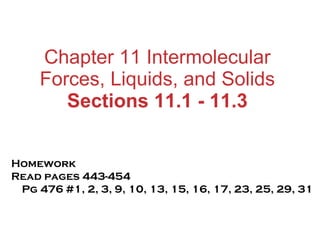
Chapter 11 Lecture- Intermolecular Forces, Liquids, & Solids
- 1. Chapter 11 Intermolecular Forces, Liquids, and Solids Sections 11.1 - 11.3 Homework Read pages 443-454 Pg 476 #1, 2, 3, 9, 10, 13, 15, 16, 17, 23, 25, 29, 31
- 20. PRACTICE EXERCISE Of Br 2 , Ne, HCl, HBr, and N 2 , which is likely to have (a) the largest intermolecular dispersion forces, (b) the largest dipole-dipole attractive forces? Answers: (a) Br 2 (largest molecular weight), (b) HCl (largest polarity)
- 26. PRACTICE EXERCISE In which of the following substances is significant hydrogen bonding possible: methylene chloride (CH 2 Cl 2 ) phosphine (PH 3 ) hydrogen peroxide (HOOH), or acetone (CH 3 COCH 3 )? Answer: HOOH
- 28. PRACTICE EXERCISE (a) Identify the intermolecular forces present in the following substances, and (b) select the substance with the highest boiling point: CH 3 CH 3 , CH 3 OH, and CH 3 CH 2 OH. Answers: (a) CH 3 CH 3 has only dispersion forces, whereas the other two substances have both dispersion forces and hydrogen bonds; (b) CH 3 CH 2 OH
- 32. Chapter 11 Intermolecular Forces, Liquids, and Solids Sections 11.4 - 11.6 Homework Read pages 455-464 Pg 477 #4, 5, 6, 35, 37, 39, 43, 45, 49, 51, 53, 55
- 35. Phase Changes
- 39. PRACTICE EXERCISE What is the enthalpy change during the process in which 100.0 g of water at 50.0°C is cooled to ice at –30.0°C? The specific heats of ice, water, and steam are 2.09 J/g-K, 4.18 J/g-K and 1.84 J/g-K, respectively. For H 2 O, H fus = 6.01 kJ/mol H vap = 40.67 kJ/mol. Answer: –20.9 kJ – 33.4 kJ – 6.27 kJ = –60.6 kJ
- 45. PRACTICE EXERCISE Estimate the boiling point of diethyl ether under an external pressure of 0.80 atm. At what external pressure will ethanol have a boiling point of 60°C? Answer: 27 C, about 340 torr (0.45 atm)
- 55. Describe any changes in the phases present when the system is (a) kept at 0°C while the pressure is increased from that at point 1 to that at point 5 (vertical line), (b) kept at 1.00 atm while the temperature is increased from that at point 6 to that at point 9. Figure 11.28 Phase diagram of H 2 O.
- 58. Chapter 11 Intermolecular Forces, Liquids, and Solids Sections 11.7 & 11.8 Homework Read pages 464- 476 Pg 477 #7, 57, 59, 71, 73, 75, 77, 79
- 59. BELLWORK Describe what happens when the following changes are made in a CO 2 sample initially at 1 atm and –60ºC: (a) Pressure increases at constant temperature to 60 atm. (b) Temperature increases from –60ºC to – 20ºC at constant 60 atm pressure.
- 72. There are two ways to define the unit cell NaCl unit cell representing appropriate ion sizes
- 74. The coordination number tells the number of particles surrounding a particular particle in a crystal. For ionic compounds & alloys there can be multiple coordination numbers.
- 75. The coordination number tells the number of particles surrounding a particular particle in a crystal. For ionic compounds & alloys there can be multiple coordination numbers.
- 76. The coordination number tells the number of particles surrounding a particular particle in a crystal. For ionic compounds & alloys there can be multiple coordination numbers.
- 77. Types of Bonding in Crystalline Solids
Editor's Notes
- 1st section needs more slides to cover all info in text